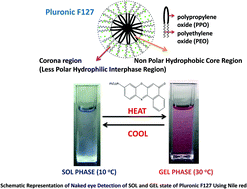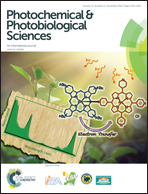Nile red fluorescence for quantitative monitoring of micropolarity and microviscosity of pluronic F127 in aqueous media†
Abstract
The photophysical behaviour and excited state decay kinetics of the fluorescent probe Nile red were used for quantitative monitoring of micropolarity, microviscosity and the sol–gel transition temperature of a copolymer hydrogel, pluronic F127. There was considerable enhancement of the emission intensity with a large blue shift in emission and an absorption maximum at and above the sol–gel transition temperature (20 °C), showing the sensitivity of Nile red fluorescence to the sol–gel transition. The estimation of micropolarity by comparing the Nile red emission maximum in dioxane–water mixtures suggested a considerable decrease in the polarity of the PF127 microenvironment from less polar (20% dioxane–water) in its sol phase to almost non-polar (90% dioxane–water) microenvironments in the gel phase. The thermotropic response of the wavelength dependent fluorescence lifetime of the probe with a rise time in the longer wavelength region has enabled monitoring of the microheterogeneity of the gel medium. With an increase in temperature, the microviscosity progressively increases from ∼10 mPa s (sol state) to ∼23 mPa s (gel state). The mismatch between microviscosity as estimated by the Nile red and the corresponding bulk viscosity reflected the microheterogeneity of the pluronic medium and its sensitivity towards PF127 microenvironments.


 Please wait while we load your content...
Please wait while we load your content...